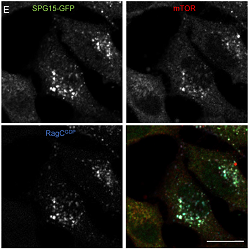
Publishing in the Journal of Cell Biology, Dr Hirst in the Robinson lab and co-authors show that recruitment of the AP-5 complex (that includes SPG11 and SPG15) is by coincidence detection, requiring both phosphatidylinositol 3-phosphate and Rag GTPases. The requirement for Rag GTPases places the AP-5 complex right at the heart of the signalling network that governs the cell’s response to starvation, uncovering an important link between the AP-5 complex and the mTORC1 pathway. These findings provide new insights into both the function of the AP-5 complex in normal cells and why its absence leads to spastic paraplegia, and could potentially open up new therapeutic approaches.

